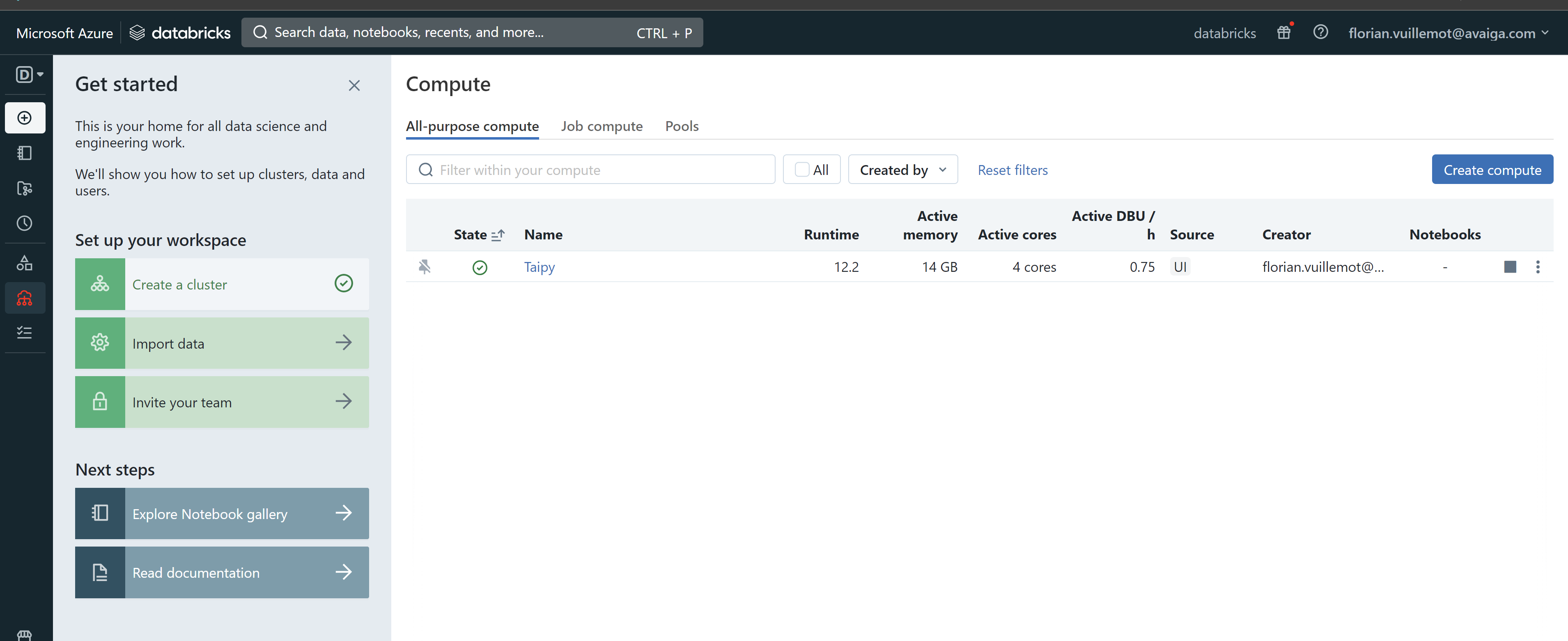Deploying on Databricks
Databricks is a standard platform for data scientists and big data engineers. It can provide a web-based development environment connected to your data source within your cloud provider. Nevertheless, Databricks does not provide a direct path to developing a web application. This documentation will show you how to adapt your infrastructure so that you can create a Taipy application in your Databricks environment.
Note
Taipy is currently only available with Databricks Standard runtimes.
Warning
We recommend using Databricks deployments for testing or demonstration purposes only.
In the current section, we consider the following as prerequisites:
- Knowledge of Databricks.
- Knowledge of SSH.
- A Databricks cluster in operation.
- A Linux-based machine that can communicate with your local machine and Databricks.
- Running a Taipy application
Note
If you don't have a Linux-based machine, you can use a cloud provider like Microsoft Azure to create one.
Running your application on Databricks¶
The first step consists in running your Taipy application on Databricks.
Let's consider the following application:
1 2 3 4 5 6 7 | |
Connect to Databricks and run the previous code in a Databricks Notebook. You should obtain an output similar to the following:
[2023-06-12 17:17:25,611][Taipy][INFO] Running in 'single_client' mode in notebook environment
INFO:Taipy:Running in 'single_client' mode in notebook environment
[2023-06-12 17:17:25,912][Taipy][INFO] * Server starting on http://127.0.0.1:5000
INFO:Taipy: * Server starting on http://127.0.0.1:5000
As you can see on the output, the Taipy application is running on Databricks and listening on
localhost (127.0.0.1:5000), which is not accessible from your browser. The next section shows you
how to expose your application.
Exposing your application¶
Here is the global architecture of the solution.
Since we can't connect to Databricks directly, we'll use an SSH tunnel between a proxy machine and the Databricks machine, enabling them to communicate. We'll also install Nginx on the Linux-based machine to route the request from your browser to your application.
In the end, the browser sends a request to Nginx on the Linux-based machine; Nginx will redirect this request to the SSH tunnel, which will redirect to the Taipy application.
Here is the technical architecture of the solution:
Warning
The Linux-based machine should be accessible from your network and from Databricks.
1- Configure the proxy using Nginx¶
We'll install and configure Nginx on the Linux-based machine to enable browser-based communication. Once configured, Nginx will redirect all incoming requests from the default HTTP port (80) to port 8080.
First, install Nginx. Then
onfigure the redirection by copying the following content in /etc/nginx/sites-enabled/default:
server {
listen 80;
location / {
proxy_pass http://localhost:8080;
proxy_read_timeout 36000s;
proxy_http_version 1.1;
proxy_set_header Upgrade $http_upgrade;
proxy_set_header Connection $connection_upgrade;
proxy_set_header Host $host;
proxy_request_buffering off;
}
}
And restart Nginx: systemctl restart nginx.
2 - Connect Databricks to the proxy machine¶
Open Databricks in a first tab, and press "Compute" and select your cluster.

Go to the "Apps" panel and select "Web Terminal". It opens a new tab with a shell.

In this shell, enter the following command, replacing username and machine-ip with your values:
ssh -R 8080:127.0.0.1:5000 <username>@<machine-ip>
Note
If your SSH authentication is based on certificates, remember to upload them on Databricks.
You are now on the Linux-based machine, and the communication is verified. You may notice the
option -R 8080:127.0.0.1:5000. This option starts
port forwarding from the machine to
Databricks.
Specifically, it forwards all packets from port 8080 to port 5000 on your Databricks notebook.
Running curl localhost:8080 should get your application's output while running on your Databricks
notebook!

3 - Access your application¶
While your first Databricks tab is open, you should be able to access your application.
On another tab of your browser, make sure you can access the application at http://<machine-ip>